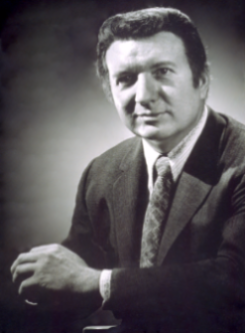One Man's Vision
 The William M. Staerkel Planetarium was the vision of the college's first president, William Staerkel, who had the idea for a planetarium and a performance theater from the inception of the college. A planetarium was in the college's original plans in 1968 and, in a physical model of the college, was depicted as a separate building. Funding finally came through in 1986 and construction began on the "Cultural Center," which included the planetarium and theatre.
The William M. Staerkel Planetarium was the vision of the college's first president, William Staerkel, who had the idea for a planetarium and a performance theater from the inception of the college. A planetarium was in the college's original plans in 1968 and, in a physical model of the college, was depicted as a separate building. Funding finally came through in 1986 and construction began on the "Cultural Center," which included the planetarium and theatre.
Dedication of the planetarium occurred on October 1, 1987, and the first public program was offered on October 22. Dr. Staerkel, though ill at the time, was present for the dedication. He passed away in December. James Manning was hired as the first director and wrote the inaugural show, Odyssey.
At the heart of the new facility was the Carl Zeiss M1015 star projector, the first of this particular model installed in the western hemisphere! The Zeiss projected 5000 stars through two star globes, plus the Sun, Moon, and the five visible planets. The Zeiss was placed on an elevator beneath a 50-foot dome, surrounded by 144 seats, some epicentric and some concentric. The epicentric seats were for the 35-mm films shown on the part of the dome. Projection was rounded out with a video projector, 56 computer-controlled slide projectors, and a host of special effects.
When East and West Germany merged, our West German star plates were replaced with plates from East Germany (drilled with lasers) and the planetarium dome grew from 5000 stars to 7600.
The "digital revolution" came in the summer of 2010. The Astro-Tec dome was repainted, the slide projectors were removed, and an Evans & Sutherland Digistar 4 projection system was installed. A new sound system was also installed. Though the iconic Zeiss still sits in the room's center, the planetarium can do more with the digital sky and fulldome programs. In August of 2016, new Irwin seats were installed so the dome was completely epicentric for a better fulldome experience. Two years later, the planetarium upgraded from Digistar 4 to Digistar 6.
The Staerkel Planetarium is the second largest planetarium in the state of Illinois and one of the largest community college planetariums in the nation!